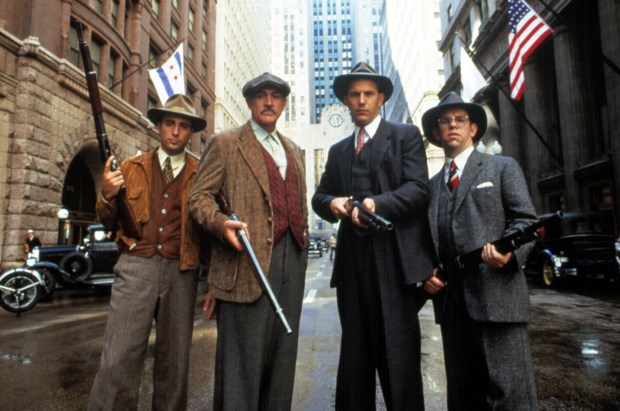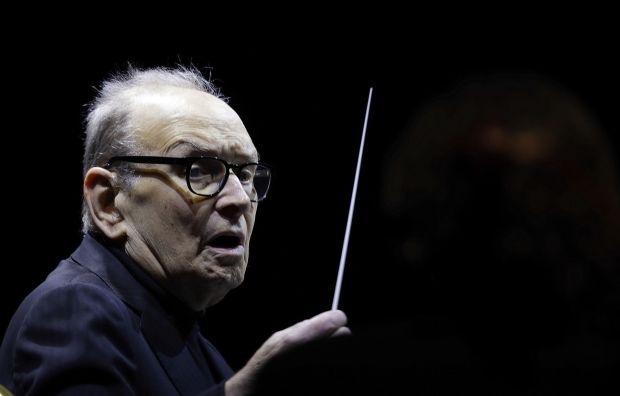Somewhere between 400 and 500. That’s a lot of film scores for one composer in one lifetime to write, and orchestrate, and store in the memory banks of millions of listeners worldwide.
The Italian maestro Ennio Morricone (1928-2020) hardly needed more than a handful of those scores for him to gain entrance to the realm of screen theme immortals. The howling-coyote signature melody for director Sergio Leone’s “The Good, the Bad and Ugly,” parodied to death for nearly 60 years now, would’ve been golden ticket enough.
But what if he had stopped there? Unthinkable! Decades and hundreds more movies, diminished. We wouldn’t have Morricone’s indelible evocations of nostalgia, and loss, and hope, in “Days of Heaven” or “Cinema Paradiso” or “The Mission.”
We wouldn’t have the rest of his collaborations with Leone, including “Once Upon a Time in the West.” Or – maybe my favorite, though I’ll change my mind by tomorrow – Morricone’s rousing sonic portrait of 1930 Chicago for Brian De Palma’s “The Untouchables.” The film itself may be factually ridiculous because it cares not about sticking to the historical record. Welcome to the movies! The score creates an aura of myth, from the first notes of the threatening marvel under the opening credits.
This Thursday the Music Box Theatre launches “Cinema Morricone,” sponsored by MUBI. It’s a weeklong, 17-film festival of movies, famous as well as obscure, celebrating the sheer scope and earworm mastery of this composer.
With one foot in the avant-garde and the other in mainstream classicism with a huge dash of pop, Morricone embraced the film medium’s innate capacity for violence (John Carpenter’s “The Thing,” screening March 22 and 27). Also its ability to break, heal and warm hearts on screen and in the audience (Giuseppe Tornatore’s achingly nostalgic “Cinema Paradiso,” March 24 and 25).
The Leone/Clint Eastwood/Morricone “ Man With No Name” trilogy takes its rightful place in the festival, along with “The Untouchables,” and some less venerated titles from the windmills of your mind. “Red Sonja,” for example (March 26-27), the Sandahl Bergman/Arnold Schwarzenegger ode to sword, sorcery and cheese. These are just a few of the titles, and “Cinema Morricone” concludes March 28 with the documentary portrait “Ennio,” directed by his friend, collaborator and “Cinema Paradiso” director Giuseppe Tornatore.
How did one man write so much so memorably, showcasing a pan flute here, an ocarina there, operatic sopranos and harmonicas and whistling (so much whistling!) everywhere? To further my musical smarts a little beyond the level of “it’s cool, therefore I like it,” I talked to Columbia College Chicago’s Kubilay Uner. He directs CCC’s Music Composition for the Screen Master of Fine Arts program. Uner also has composed for movies (“Force of Nature”), theme park rides (Corkscrew Hill at Busch Gardens) and video art installations (he’s in the permanent collection at Los Angeles County Museum of Art).
The “Cinema Morricone” festival, Uner told me the other day, arrives at a great time. “I’m on spring break!” he says, calling via Zoom from Los Angeles, where he attended the pre-Oscars reception for this year’s musical nominees. “I didn’t even know about this Music Box festival; I’m just so ensconced in school and in my own work, in the studio. But now I’m definitely going.”
Our conversation has been edited for clarity and length.
Q: Kubilay, would you describe yourself as a Morricone fan?
A: No. I’d describe myself as an enormous Morricone fan. (laughs)
Q: Was there a particular score of his that caught your ear when you were young?
A: Yes, and this was many years before I even understood that there were really such things as film composers. I started out as a musician, a bass player, and didn’t think much about film music. I lived in Brazil for a year when I was 16; I was born and raised in Munich, though we lived in Canada for a while, and I went to Brazil as an exchange student, then back to Germany, then I left in my early 20s to study in the U.S. And never went back.
So as an exchange student, I went to a repertory theater where they were showing a really wild Marlon Brando film called “Queimada” (“Burn!” in its U.S. release), directed by Gillo Pontecorvo. This was in the ‘70s, though it originally came out in 1969. That film blew my mind. It’s set on a Caribbean island in the 1840s. Very dark, very political. And Morricone’s music really blew my mind. It’s heavily choral, very raw, very late ‘60s.
A while later, I caught up with “The Good, the Bad and the Ugly.” Again: mind blown, especially when I realized both scores came from the same composer.
Q: Why does Morricone do it for you, all these decades later?
A: Three things, I think. One, he’s super innovative, even when he’s writing in a traditional mode. There’s something in the execution of what he writes, and in how he orchestrates, that’s completely original. Two, he’s just so expressive, emotional, aggressive, rousing. His work is rarely understated, and I suppose that jibes with me (laughs).
And three: Morricone knew no boxes. He worked in every genre, Westerns, gangster films, romances, everything. For him, everything was fair game.
Q: Here’s a quote from “Ennio Morricone: In His Own Words,” conversations with Alessandro De Rosa, where he’s talking about music’s main function in relation to what’s on the screen. He quotes his friend Gillo Pontecorvo: “My friend used to say that behind every story cinema tells, there is a real story, one that really counts … music must find a way to bring out the value of that hidden story and highlight it.” That’s a really intriguing description of a film composer’s role, don’t you think?
A: I think all film composers can relate to that. There’s something fundamentally useless, most of the time, if you’re just duplicating with music what the film is already doing. Now, there are exceptions. Sometimes you want everybody (executing) the same moves for maximum impact, so the visuals, the storyline, the acting, the editing and the music all push one thing. That’s great for a high-intensity fight scene.
But a lot of the time, and what Morricone’s so smart about, is what he’s describing in that quote, which is more prosaically called the subtext. There, the question for the composer becomes: What’s actually happening in the scene? It’s an essential description of what film music is supposed to do.
Q: Morricone started as an arranger, and got his first on-screen composing credit for “The Fascist” in 1961. His output is staggering, across six different decades. Do you think he ever felt burned out, or that he’d sold out?
A: I don’t think so. I don’t think you can write close to 500 scores with themes of his quality without believing in them. Even in his most accessible film scores, he’s pushing boundaries somewhere, with interesting chord progressions you just don’t hear in other movies.

Q: Until a decade or two ago I didn’t realize Morricone, and other film composers, often composed and sometimes recorded music before a film was actually shot. De Palma, in one interview, talks about “The Untouchables” (March 22 and 26), which is a score I love. Morricone read the script and met up with De Palma in New York for a few days and talked, and Morricone wrote several versions of four main themes for the picture on that trip. That kind of impressionistic film scoring versus scoring specifically to the director’s images —
A: — It does lead to a different result, obviously. I’m extrapolating, but I wonder if it aids in creating a kind of parallel story, the story underneath the story, that Morricone mentioned in that quote from the book. It’s not a super rare approach; some of the music by Trent Reznor and Atticus Ross (Oscar winners for “The Social Network” and Pixar’s “Soul”) I think was written that way. There was some criticism leveled at them from those who believe that isn’t really scoring in the purest sense.
But think about the very beginning of music and movies: It was some dude sitting at a piano with a book of classical themes in the public domain, themes sorted by emotion or whatever. Love scene? Boom! Something by Brahms! Chase scene? Boom! Wagner! That’s how it all started, in a way.
Looking at the Music Box schedule, there’s so many films Morricone worked on I’ve never heard of. “The Bird with the Crystal Plumage” (Dario Argento’s 1970 horror outing, March 24)? I mean I’d see it just based on the title. Same with “Machine Gun McCain” (1969 gangster drama with Peter Falk, John Cassavetes and Britt Ekland, March 25). And I can’t wait to hear “Once Upon a Time in America” again (March 22).
Q: The pan flute! Morricone loved it! The “Once Upon a Time in America” score marks the pan flute’s finest screen hour.
A: No doubt. It’s always wonderful to revisit Morricone’s scores with the soundtracks, on vinyl or CD or streaming. I did it yesterday on the plane out to L.A., to refamiliarize myself before we talked. But it’s just completely different when you’re watching the movie in a theater, hearing the score as it was intended to be heard.
It’s the difference between watching a tiger in the zoo and watching a tiger in the jungle, where the tiger belongs.
“Cinema Morricone,” March 21-28, Music Box Theatre, 3733 N. Southport Ave.; 17-film passes, $60-$80. Individual screenings, $8-$11. More information at musicboxtheatre.com/series-and-festivals/cinema-morricone
Michael Phillips is a Tribune critic.



